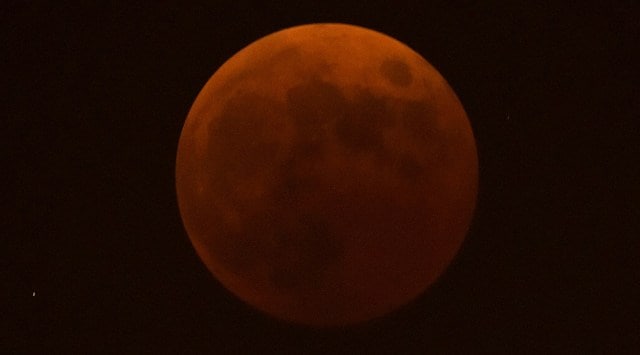The penumbral lunar eclipse on May 5, and other eclipses: How do they work?
The penumbral lunar eclipse, or Chandra Grahan, on May 5 will be difficult to notice. Here is everything you need to know about lunar eclipses and how they happen.
 The moon rises during a lunar eclipse in Beijing, Tuesday, Nov. 8, 2022. (AP Photo/Mark Schiefelbein)
The moon rises during a lunar eclipse in Beijing, Tuesday, Nov. 8, 2022. (AP Photo/Mark Schiefelbein) Following the hybrid solar eclipse on April 20, skywatchers in many parts of the world, including India, are going to get a chance to catch a glimpse of a penumbral lunar eclipse in action on Friday, May 5. Ahead of that, here is everything you need to know about lunar eclipses and their different types.
Lunar eclipses are not nearly as rare as solar eclipses. Once or twice or more times every year, the Earth, the Moon and the Sun line up in just the right way to create the “shadowplay” that we call an eclipse, according to NASA.
The reason this does not happen every month is because the Moon’s orbit around our planet is tilted relative to Earth’s orbit around the Sun. This means that the cosmic alignment does not happen each time the Moon makes a full orbit around our planet.
 Visibility map of the lunar eclipse on May 5. (Image courtesy: In the Sky)
Visibility map of the lunar eclipse on May 5. (Image courtesy: In the Sky)
How does a lunar eclipse happen?
Lunar eclipses only occur during a full moon. When the Earth is situated precisely between the Moon and the Sun. the Earth’s shadow falls on the Moon’s surface. This dims or obscures the sunlight that is reflected by the Moon. Sometimes, this dimming or obscuration can cause the Moon to turn slightly red.
Why does the Moon turn red during a lunar eclipse?
During some lunar eclipses, parts of the Moon obscured by the Earth’s shadow take on a reddish tinge. This is due to a phenomenon known as Rayleigh scattering. Essentially, during those times, the only sunlight reaching the Moon is the light that passes through our planet’s atmosphere first. Since our atmosphere scatters the bluer wavelengths of light, only the redder part of the light spectrum is let through.
It is unlikely that the Moon will turn red during the May 5 eclipse since it is a penumbral eclipse.
What are the different kinds of lunar eclipses, and what are the differences between them?
There are three different kinds of lunar eclipses—total, partial and penumbral.
Total lunar eclipse
When the Moon moves into the inner part of the Earth’s shadow, or the umbra, it results in a total solar eclipse. Usually, a total lunar eclipse is when the Moon appears to turn a shade of red. As mentioned earlier, this is because of light passing through our planet, reaching the Moon and Rayleigh scattering.
 Lunar Eclipse 2022: This combination of photos shows the moon in various stages of a total lunar eclipse during the first blood moon of the year in Temple City, Calif. May 15, 2022. (AP Photo/Ringo H.W. Chiu)
Lunar Eclipse 2022: This combination of photos shows the moon in various stages of a total lunar eclipse during the first blood moon of the year in Temple City, Calif. May 15, 2022. (AP Photo/Ringo H.W. Chiu)
Partial lunar eclipse
When the Sun, Earth and Moon aline imperfectly, and only a portion of the Moon passes through the Earth’s umbra, you get a partial lunar eclipse. During a partial eclipse of the Moon, the dark shadow of the Earth will slowly grow on the Moon, before it starts receding. The dark shadow will not completely cover the Moon during a partial lunar eclipse.
 The moon is seen during a partial lunar eclipse in Shanghai January 1, 2010. (REUTERS)
The moon is seen during a partial lunar eclipse in Shanghai January 1, 2010. (REUTERS)
Penumbral lunar eclipse
The May 5 eclipse is a penumbral lunar eclipse. What does that mean? During a penumbral eclipse, the Moon only travels through the Earth’s penumbra, which is the faint outer part of its shadow. Due to this, the Moon dims so slightly that you might actually miss it unless you pay close attention.







